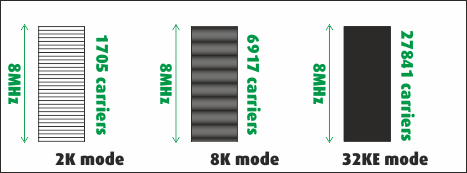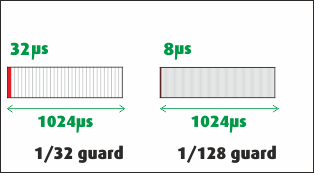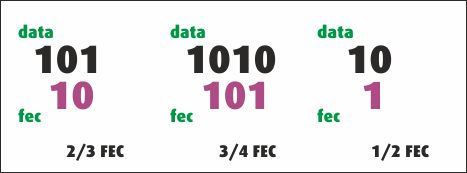Freeview modes - a simplified explanation
 Brian Butterworth published on UK Free TV
Brian Butterworth published on UK Free TV As mentioned in How digital television works Freeview signals can be broadcast in a number of different "modes", which are a combination of five parameters. Some of these have changed over the years because the increase in computing power has made more efficient methods of broadcasting cheap enough to fit in a set-top box - it is now possible to broadcast high definition television or more standard definition services on the same physical wavelength.
As some of the ideas that are implemented would fill a text book by themselves, I have presented the concepts in a simplified way.
Sub-carriers
Each Freeview multiplex is broadcast within an 8MHz channel that was originally allocated to analogue television. Rather than being a single broadcast, the channel is split into a number of different signals that sit next to each other.The original digital terrestrial broadcasts (from the launch of ONdigital) used 1,705 sub signals (referred to as 2k mode) about 4,600 Hz apart. After switchover 6,817 subcarriers (8k mode) means the signals are 1,170 Hz apart, with the high definition service using 27,841 (32ke) subcarriers just 280Hz apart.

It is possible to space carriers so close together because they are carrying digital information, in the analogue domain the problem with sidebands would render a similar system useless.
Symbol duration
For reasons detailed below, the information is not transmitted in single bits on each carrier, but as groups of bits which are referred to as "symbols". Each symbol is held in the transmission system for a given duration, 1024 us. The longer this time is, the less information is carried, but too short a duration for each symbol would not allow the receiver to detect the information correctly.Guard interval
Each subcarrier also uses a guard interval, which turns off each carrier as part of the transmission cycle. With SD broadcasts, this is 1/32th of the symbol time (32us), on HD it is 1/128th (8us). The guard intervals start each symbol and exist to deal with the problems of multipath - where the signal is being received directly and also by reflections.
Forward error correction
In non-synchronous digital transmission systems, such as those used for the internet, the presence of data corruption between the sender and receiver can be signalled back to the source and the data resent.However, a digital broadcast is a one-to-many unidirectional system, with no ability to ask for data to be resent.
For this reason, the transmissions use "forward error correction", which is a system that allows a certain level of errors to be detected.
The most basic form of a forward error correction (FEC) would be to transmit each bit twice - as long as each bit was sent along a separate subcarrier, then a single bit loss on one carrier could corrected by using the one sent on the other carrier. However, this is very inefficient, as it reduces the useful capacity of the system by half.

So, instead the DVB-T system uses a Punctured Convolution coding system. Instead of sending each bit twice, bits are grouped and then a code that describes the bits in a way that a single bit error can be detected and corrected most of the time.
Quadrature amplitude modulation
In the above descriptions, the word "symbol" was used to describe what is transmitted. You may have thought that a digital system would transmit information on the subcarriers as bits. However, doing this in a broadcast system is actually unproductive.For this reason, quadrature amplitude modulation is used. This takes the incoming bits and encodes them in groups. The most basic form encodes bits two at a time, using sine (Q) and cosine (I) functions that are then added to the main carrier. In effect "00" is encoded as -Q-I, "11" as +Q+I, with "01" and "10" being +Q-I and -Q+I.

At the next level, as used for DVB-T, the bits are encoded in groups of four bits (16QAM) or eight bits (64QAM), with DVB-T2 being groups of 16 bits (256QAM).
UK Freeview modes
There are 10 modes defined for use in the UK, these are:- Mode 1: DVB-T 1705 (2K) carriers, 64QAM mode, FEC=2/3, 1/32 guard = 24.13Mbps
- Mode 2: DVB-T 1705 (2K) carriers, 16QAM mode, FEC=3/4, 1/32 guard = 18.1Mbps
- Mode 3: DVB-T 6817 (8K) carriers, 64QAM mode, FEC=2/3, 1/32 guard = 24.1Mbps
Mode 4: DVB-T2 6913 (8KE) carriers, 64QAM mode, FEC=4/5, 1/32 guard = 34.7MbpsunusedMode 5: DVB-T2 27841 (32KE) carriers, 256QAM mode, FEC=3/5, 1/128 guard = 36.1Mbpsunused- Mode 6: DVB-T2 27841 (32KE) carriers, 256QAM mode, FEC=2/3, 1/128 guard = 40.2Mbps
- Mode 7: DVB-T 6817 (8K) carriers, QSPK mode, FEC=1/2, 1/32 guard = 6.0Mbps
- Mode 8: DVB-T 6817 (8K) carriers, 64QAM mode, FEC=3/4, 1/32 guard = 27.1Mbps
"high capacity commercial multiplex mode". Mode 9: DVB-T2 27265 (32KN) carriers, 256QAM mode, FEC=3/5, 1/128 guard = 35.2Mbpsunused- Mode 10: DVB-T2 27265 (32KN) carriers, 256QAM mode, FEC=2/3, 1/128 guard = 39.2Mbps
- Mode 11: "Northern Ireland mode" details TBC
Diagram showing capacity for each mode:

Help with Television sets?
Tuesday, 15 November 2011
J
Jane Hore7:23 PM
I obviously forgot to post my previous comment!
I have lost ALL TV reception, Signal Strength showing at 0%.
I am not vacuuming, using a power tool, doing the washing...
| link to this comment |
Wednesday, 16 November 2011
J
Jim F11:05 AM
Jane Hore: Your TV set (even though its new) could well be faulty - it does happen. If you could borrow a digibox from somewhere, you could use that connected to your TV via a SCART lead to test the incoming signal (if the digibox works fine then the TV's tuner / decoder is duff).
The other option would be to take your TV to someone with a known good signal (neighbour?) and see if it's still playing up.
| link to this comment |
Friday, 18 November 2011
M
MikeB8:20 AM
I have experienced signal breakup/loss earlier this week but mainly on BBC channels. Signal strength from Waltham on my Humax 9300T was shown to be down to 50% and the picture was often lost. However, aerial pass through to my Samsung television was better at 70% signal strength, and the picture was still fine. How can this happen?
| link to this comment |
J
jb388:54 AM
MikeB: Are you absolutely positive that the TV and the Humax are receiving BBC channels from the same station? this obviously checked upon by noting the Mux channel number being indicated on each device associated with the signal strength being shown. (Waltham BBC Mux Ch61)
This possibility is only mentioned because you haven't given your location, (post code) and its known that numerous people in the Waltham (as well as other) reception areas are capable of picking up signals from more than one station.
| link to this comment |
Sunday, 20 November 2011
G
greg7:43 PM
Saffron Walden
we are on the Sudbury transmitter and since 16th november we have lost channel 13, 15 and most of the digital radio stations on VHF63. Before 16th we had a good signal, after zero signal. what has gone wrong?
| link to this comment |
greg's: mapG's Freeview map terrainG's terrain plot wavesG's frequency data G's Freeview Detailed Coverage
Thursday, 24 November 2011
L
Liam Leckie8:17 PM
On Crystal Palace transmitter. Since Sunday 20th Nov we have lost all Freeview HD channels. BBC1 ITV1 Channel 4 BBC HD. Re-tunning has now left a gap for channels 50 - 60
| link to this comment |
L
Liam Leckie8:48 PM
Thanks Dave... That worked... I have also retuned and the Freeview HD Channels are now back
| link to this comment |
Saturday, 26 November 2011
J
Johnc8:30 AM
Not picking up HD channels after DSO stage 2 at Tacolneston. Got a Humax PVR-9150T connected to Hitachi L26H01U via SCART.
During re-tuning both boxes after DSO2, channel 62 at 801.8 mHz simply is not presented. Both boxes show that there's no signal being detected. Might this be a problem with the aerial?
Have seen mention of needing 'aerial group C Position D/H'. Haven't a clue what this means, nor what type of aerial I've currently got.
Have also seen mention of needing to connect boxes via HDMI lead. That may be true, but it wouldn't affect tuning... or would it?
| link to this comment |
Johnc: Neither of those devices have HD tuners in!
The Humax PVR-9150T does not even have a HDMI socket on the back which is a bit of a giveaway.
| link to this comment |
Select more comments
Your comment please!